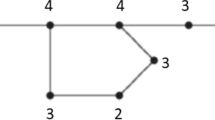Abstract
Inspired by the potential computational capability of 3-Dimensional (3D) DNA structure, this paper presents a graph structure constructed by k-armed (k = 3 or 4) branched junction DNA molecules to explore the possibility of solving some intractable problems. In the proposed procedure, vertex building blocks consisting of 3, 4-armed branched junction molecules are selectively used to form different graph structures. After separating these graph structures by gel electrophoresis, the connectivity of this graph can be determined. Furthermore, the amount of potential solutions can be reduced by a theorem of graph theory.
Similar content being viewed by others
References
L. Adleman. Molecular computation of solutions to combinatorial problems. Science, 266(1994)11, 1021–1024.
R. Lipton. DNA solution of hard computational problems. Science, 268(1995)4, 542–545.
Q. Ouyang, P. D. Kaplan, S. Liu, et al. DNA solution of the maximal clique problem. Science, 278(1997)10, 446–449.
Q. Liu, L. Wang, A. G. Frutos, et al. DNA computing on surfaces. Nature, 403(2000)1, 175–179.
N. C. Seeman, J. H. Chen. Synthesis from DNA of a molecule with the connectivity of a cube. Nature, 350(1991)4, 631–633.
N. Jonoska, S. A. Karl, M. Saito. Three dimensional DNA structures in computing. Biosystems, 52(1999)10, 143–153.
N. C. Seeman, Y. Zhang, S. M. Du, et al. Construction of DNA polyhedra and knots through symmetry minimization. Supermolecular Stereochemistry, ed. by J. S. Siegel, NATO Advanced Research Workshops Series, Kluwer, Dordrecht, 1995, 27–32.
D. Rinehard. Graph Theory. New York, Springer-Verlag, Electronic Edition 2000, 9–12.
J. A. Bondy, U. S. R. Murty. Graph Theory with Applications. New York, Macmillan, 1976, 46–47.
R. Holliday. Induced mitotic crossing-over in relation to genetic replication in synchronously dividing cells of ustilago maydis. Genetic Research, 10(1965)2, 104–120.
P. Sa-Ardyen, N. Jonoska, N. C. Seeman. Self-assembling DNA graphs. DNA Computing, 8th International Workshop on DNA-based Computers, Sapporo, Japan, June 10–13, 2002, 1–9.
N. C. Seeman, J. H. Chen, N. R. Kallenbach. Gel electrophoretic analysis of DNA branched junction. Electrophoresis, 10(1989)6, 345–354.
K. Yamada, M. Ariyoshi, K. Morikawa. Three-dimensional structural views of branch migration and resolution in DNA homologous recombination. Current Opinion in Structure Biology, 14(2004)4, 130–137.
Q. Yang, A. Lishanski, W. Yang, et al. Allele-specific Holliday junction formation: a new mechanism of allelic discrimination for SNP scoring. Genome Research, 13(2003)7, 1754–1764.
Author information
Authors and Affiliations
Corresponding author
Additional information
Supported by the National Natural Science Foundation of China (No. 30370356 and No. 60574041).
About this article
Cite this article
Fang, G., Zhang, S., Zheng, A. et al. The molecular algorithm of connectivity based on three dimensional DNA structure. J. of Electron.(China) 24, 104–107 (2007). https://doi.org/10.1007/s11767-005-0128-4
Received:
Revised:
Published:
Issue Date:
DOI: https://doi.org/10.1007/s11767-005-0128-4




